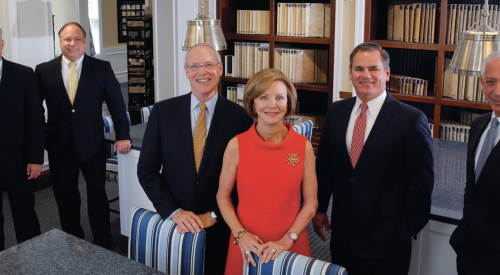|
When Congress extended and expanded the home-buyer tax credit last November, Pat Neal was ready for it. The CEO of Lakewood Ranch, Fla.-based Neal Communities ramped up his operations. His staff listed 68 spec homes that will be completed and ready to sell by the June 30, 2010 closing deadline, started an additional six spec homes and began working on a production line for 24 more houses. Neal beefed up his purchasing and accounting staff, and has four people in his land department “reaching out for bargains everywhere.” He also added another superintendent to make sure the houses get done in time to meet the deadline.
“We think that will be the limiting factor,” Neal says. “We think we'll be able to sell more homes than we can complete by June 30.”
| Neal Communities is among the many home builders that are ramping up operations to take advantage of the extended and expanded home-buyer tax credit. CEO Pat Neal expects sales to be 20 percent higher than 2009 — no mean feat in southwest Florida. Shown here is Forest Creek in Parrish, Fla. Photo: Perry Johnson |
The impact of the tax credit could be substantial. The National Association of Home Builders (NAHB) estimates that the availability of the credit will produce an additional 180,000 home sales this year, create 211,000 jobs and generate nearly $10 billion in wages.
But with the extension and expansion of the tax credit, Congress has made it clear that the housing industry shouldn't expect any additional stimulus money from the federal government. No more extensions, either. With the exception of active military personnel serving outside the United States, first-time and existing home buyers need to sign a contract on a home by April 30, and close on the sale by June 30.
“This is it,” says Robert Dietz, NAHB's assistant vice president for tax and policy issues. “People need to take that deadline seriously.”
With such a short time frame, builders can't waste time or energy on anything that won't produce sales. While the new tax credit includes buyers who have owned a home for at least five of the last eight years, many builders have opted to continue focusing on the market with the best chance of closing before the deadline: first-time home buyers without a house to sell.
“We've had problems with move-up buyers the last four or five months,” Neal says. “Most of them are stuck in their previous homes. They either have no equity, negative equity or they defaulted so they have bad credit. We are not marketing to them at this time.”
|
NAHB estimates that the availability of the credit will produce an additional 180,000 home sales this year, create 211,000 jobs and generate nearly $10 billion in wages. |
To spread the word, builders have ramped up their marketing. Royal Oaks Building Group in Raleigh, N.C., is running a “Double Your Tax Credit” promotion, offering an $8,000 incentive package that buyers can use for a price reduction, assistance with closing costs or upgrades.
Company President Rich Van Tassel took advantage of a late cancellation to get the cover and two inside pages of the local new-homes guide for January and February. He's also produced a 30-minute weekly cable TV show and added a marketing manager to his staff.
“We're trying to jump-start our year, using the catalyst of the tax credit,” Van Tassel says.
Marketing, of course, will only take a builder so far. The sales staff needs to be well-versed in the particulars of the tax credit to be able to explain it clearly to prospective buyers.
“People prefer to do business with an expert,” says new-home sales educator Myers Barnes of Myers Barnes Associates, Kitty Hawk, N.C. “A confused buyer who feels disoriented regarding the rules cannot buy.”
Barnes' advice is to “turn every salesperson into an expert.” He recommends using the information available on the NAHB's tax-credit Web site to create a fact sheet about the credit.
NAHB's Dietz strongly encourages builders to make full use of the Web site. “It's the most authoritative site out there,” he says. “There's no need to recreate the wheel. Link to it, cut and paste from it. The industry needs to use it more.”
Glenn Tatangelo, owner of The Woodland Group in Trumbull, Conn., says that his sales associates not only are trained to discuss the tax credit, but also to help buyers who think they can't qualify for a mortgage.
“We say, 'Let us find out for you,'” Tatangelo says. “I want to make sure we have constant communication and walk them through the appraisal and financing processes.”
Any sales and marketing push needs to be preceded by a capability to deliver homes to prospective buyers by the deadline. Lot-buying activity has quickened in the last few months in several markets, but builders shouldn't have trouble lining up finished lots at attractive prices or finding trade contractors to handle the increased volume. Builders should take some proactive steps to get permits pulled, says Steve Hays, partner in charge at the RubinBrown Home Builders Services Group in St. Louis.
Hays also recommends that builders talk to their lenders about funding to build specs. “If you don't have specs, you're going to miss the market,” he says. “At this price point, a lot of people don't want to wait to have a house built. And if a move-up buyer does sell their house, they want to buy something now. If you don't have anything available, you're going miss a sale.”
Nationally known business consultant Chuck Shinn, president of the Shinn Group in Littleton, Colo., cautions that for most builders the biggest challenge to taking advantage of the tax credits will be re-implementing the systems that have been shelved since the market collapsed. These include purchase orders, warranty programs, construction schedules and contract arrangements with trade contractors.
| “I’ll be back at the same production level in 2010 as in the summer of 2005, with 40 percent less employees.” — Pat Neal |
“Builders need to go back to processes and procedures and become really efficient at what they're doing,” says Shinn. “They probably need to select a couple of communities to focus on, and they may need to change product.”
That product has to match the needs of the targeted consumer: the entry-level buyer who has been living in an apartment. “There's some pretty decked-out two-bedroom apartments,” he says.
The one thing Shinn doesn't recommend is re-hiring a lot of staff. There's no guarantee that the flurry of activity from the tax credit will continue after it expires — and most builders have streamlined their operations to make do with less overhead anyway. It's a lesson that Pat Neal has learned, and he has no plans to bring back staff.
“I'll be back at the same production level in 2010 as in the summer of 2005, with 40 percent less employees,” Neal says.
To accommodate the increased activity, Shinn recommends outsourcing such functions as purchasing, architectural plans, estimating and selections. “Builders ought to look at those instead of hiring people, which is sticky overhead that's hard to get rid of,” he says. “It allows a small builder to play the game like the publics. If they take advantage of some of this, they can look like a huge builder with really talented people and still be a small operation.”
The question in the back of everyone's mind, of course, is what will happen after the tax credit expires. Shinn points out that the two largest buyer demographics are baby boomers who are downsizing and 20-something Millennials who are first-time buyers and want smaller, more open plans.
“It will be a very interesting market,” he says. “Prepare yourself for the resurgence. We've bottomed out; we're going to come back. Hopefully this stimulus leads us into a period of time where recovery is in place.”
Neal is planning for just that scenario, and given that he's been a home builder long enough to have gone through several downturns (“I've seen this movie five times,” he says), he's got history to support his plans. His current projection is to sell 379 units in 2010 — in southwest Florida, one of the worst markets in the country. That will be about 20 percent more than the company sold in 2009 (with 30 to 50 of those coming from the tax credit). Neal sees 2010 as a year to generate cash flow from land sales and to keep his people working. He anticipates a much stronger year in 2011.
“We were in survival mode in 2009,” he says. “This year, we'll be in enhanced survival mode. In 2011 and 2012, we plan to make money and have fun.”
|











